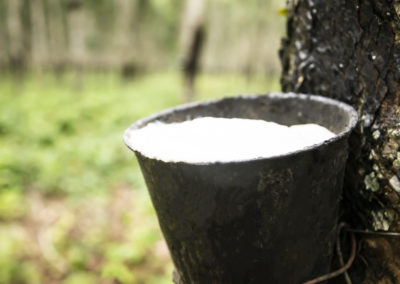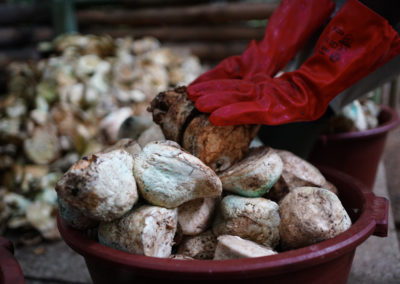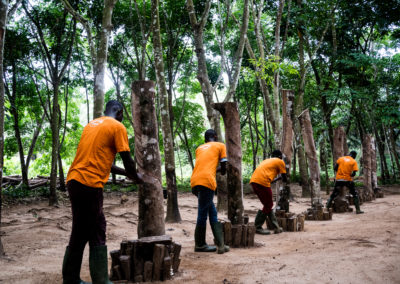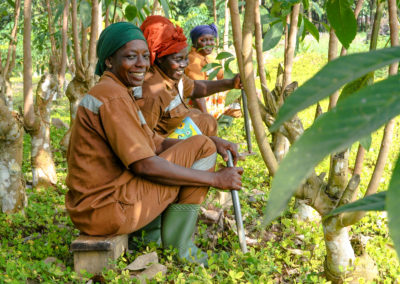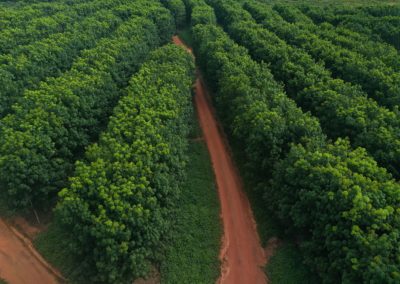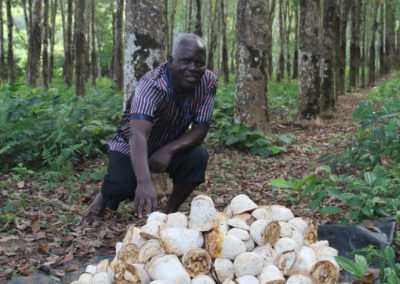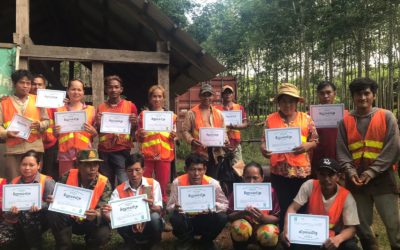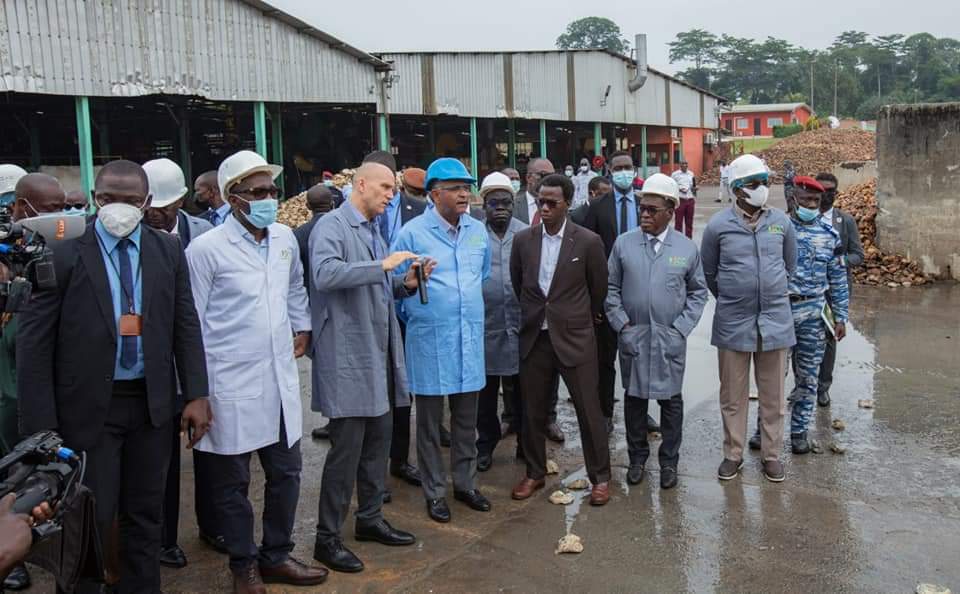Rubber
14.57 MT
Global production
160 200 T
88 200 T
60 800 ha
Planted surface by Socfin
Rubber
Hevea, the rubber tree
Natural rubber results from the coagulation of the latex from the rubber tree. This latex, not to be confused with the sap, flows in a separate network of specialized vessels in the bark of the tree: the lactiferous vessels. Obtained from the first latex transformation or coagulated cup lumps in the field, natural rubber does not contain any solvents.
Where does rubber grow?
Rubber is native to South America. Its cultivation has spread to all tropical regions, more specifically to Southeast Asia as well as West and Central Africa.
Rubber cultivation
Since the mid-twentieth century, all plantations have used selected plant material obtained through grafting. Rootstocks are raised in nurseries for six months before receiving a graft. These small rubber trees are then transplanted into the field, with a density of about 500 to 550 trees per hectare. After six years, they reach physiological maturity and the vegetative stage allowing for the start of tapping, through a fine incision in the bark to extract the latex. Rubber trees are a significant carbon sink, very useful in the fight against global warming. The rubber tree has a lifecycle of almost 30 years: when the trees’ yield decreases, the timber can be used for furniture, pulp or even firewood, or else it can be left in the field to decay naturally and maintain a good level of organic matter in the soil.
Harvesting
Harvesting starts with a fine incision in the bark of the tree. This operation makes it possible to transect the lactiferous vessels, allowing the latex to flow. It is harvested into cups placed below the tapping notch. Generally, tapping is done every 4 days, and the latex in the lactiferous vessels is renewed after harvesting.
Rubber can be harvested in a liquid state – latex – or after coagulation in the field (cup lumps). It is then taken to the rubber factory.
A simple and sustainable treatment process
At the factory, the cup lumps are stored in bunkers for several weeks before processing. Then this raw material is washed, mixed, granulated and dried several times before being pressed in 35kg bales. Strict adherence to quality standards throughout the processing process ensures compliance with end-users’ requirements. The finished product is then labeled “Technical Specified Rubber” (TSR).
Green energy supply
Our rubber factories are powered by green or renewable energy sources. Hence, our rubber dryers can be powered by wood of felled rubber trees or by electricity from solar, wind and hydroelectric installations.
Natural rubber is desired for its physical properties:
- Low thermal conductivity
- Elasticity
- Impact resistance
- Vibration and noise damping qualities
For more than 20 years, the Socfin Group has invested in research and development to ensure responsible tropical agriculture. Please have a look at our Research webpage and learn more about the various actions taken in the domain of rubber cultivation, among others.
Rubber, a raw material used in many domestic and medical objects:
|
|
Origin |
Annual global consumption | Products |
|
| Natural rubber | Extracted from the rubber bark | 48% of annual global consumption | Tyres, manufactured articles, elastic thread, carpets, surgical protection products, condoms, glue… |
|
| Synthetic rubber | Derived from natural gas and petroleum by-products | 52% of annual global consumption | Tyres, manufactured articles, elastic thread, carpets, surgical protection products, condoms… |
|
Latest news
New graduates at Socfin Cambodia’s tapping school
Congratulations to the latest graduates from Socfin Cambodia’s tapping school in the plantation of Coviphama! After successfully completing their one-month training they will join their new colleagues from the tapping teams on the field. Do you also want to join our...
Côte d’Ivoire : Visite du premier Ministre Patrick Achi à la SCC
Son Excellence le Premier Ministre ivoirien, Monsieur Patrick Achi était en visite dans le Sud-Comoé le samedi 2 avril 2022. Lors de son passage dans la région, il a souhaité visiter le centre de transformation du caoutchouc de la SCC.
Hévéaculture : comment restaurer la santé des sols après l’abattage d’une plantation de 40 ans ?
La restitution de la biomasse des arbres abattus et l’installation d’une couverture de légumineuse permettent une restauration rapide des principales fonctions du sol, 18 mois après l’abattage d’une plantation d’hévéas en fin de cycle. Une équipe de chercheurs en a...

